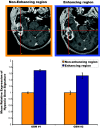Identification of noninvasive imaging surrogates for brain tumor gene-expression modules
- PMID: 18362333
- PMCID: PMC2278224
- DOI: 10.1073/pnas.0801279105
Identification of noninvasive imaging surrogates for brain tumor gene-expression modules
Abstract
Glioblastoma multiforme (GBM) is the most common and lethal primary brain tumor in adults. We combined neuroimaging and DNA microarray analysis to create a multidimensional map of gene-expression patterns in GBM that provided clinically relevant insights into tumor biology. Tumor contrast enhancement and mass effect predicted activation of specific hypoxia and proliferation gene-expression programs, respectively. Overexpression of EGFR, a receptor tyrosine kinase and potential therapeutic target, was also directly inferred by neuroimaging and was validated in an independent set of tumors by immunohistochemistry. Furthermore, imaging provided insights into the intratumoral distribution of gene-expression patterns within GBM. Most notably, an "infiltrative" imaging phenotype was identified that predicted patient outcome. Patients with this imaging phenotype had a greater tendency toward having multiple tumor foci and demonstrated significantly shorter survival than their counterparts. Our findings provide an in vivo portrait of genome-wide gene expression in GBM and offer a potential strategy for noninvasively selecting patients who may be candidates for individualized therapies.
Conflict of interest statement
Conflict of interest statement: M.D.K. has filed a patent application in an area related to this field of work.
Figures




References
-
- Nutt CL, et al. Gene-expression-based classification of malignant gliomas correlates better with survival than histological classification. Cancer Res. 2003;63:1602–1607. - PubMed
-
- Freije WA, et al. Gene-expression profiling of gliomas strongly predicts survival. Cancer Res. 2004;64:6503–6510. - PubMed
-
- Bredel M, et al. Functional network analysis reveals extended gliomagenesis pathway maps and three novel MYC-interacting genes in human gliomas. Cancer Res. 2005;65:8679–8689. - PubMed
-
- Phillips HS, et al. Molecular subclasses of high-grade glioma predict prognosis, delineate a pattern of disease progression, and resemble stages in neurogenesis. Cancer Cell. 2006;9:157–173. - PubMed
Publication types
MeSH terms
Substances
Grants and funding
LinkOut - more resources
Full Text Sources
Other Literature Sources
Medical
Research Materials
Miscellaneous

